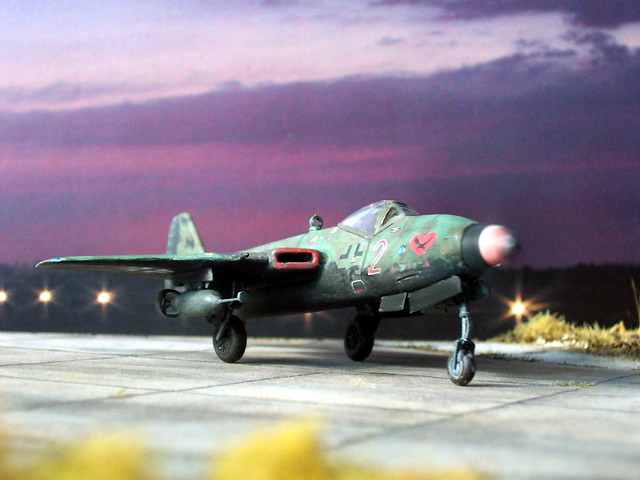Ein Interims-Bau, während ich auf Teile für zwei andere Projekte warte(te): eine persönliche Interpretation des Focke Wulf-Projektes "P.VIII", das aus dem nicht akzeptierten "Flitzer" entwickelt worden war. Hatte ich schon länger auf der Agenda, und einen Revell-Flitzer auf Halde, also flugs am Wochenende Säge und Spachtelkelle angesetzt, und dies ist daraus (leicht rustikal) geworden:


 Some background:The Focke-Wulf Project VII Flitzer ("streaker" or "dasher", sometimes incorrectly translated as "madcap") was a jet fighter under development in Germany in World War II.
Some background:The Focke-Wulf Project VII Flitzer ("streaker" or "dasher", sometimes incorrectly translated as "madcap") was a jet fighter under development in Germany in World War II.
The design began as Focke-Wulf Project VI which had a central fuselage and two booms carrying the rear control surfaces having great similarity with the de Havilland Vampire. Project V had the air inlets still positioned on either side of the nose, just below the cockpit.

The estimated horizontal speed was not satisfactory and in the next development, Project VII, the jet intakes were situated in the wing roots. Further improvements over Project VI were a narrower fuselage and a changed pilot's canopy. In order to improve the rate of climb, a Walter HWK 109-509 hypergolic liquid-propellant rocket was added.
In spite of the fact that a complete mock-up was built and all construction and assembly plans finished, the aircraft was not accepted by the RLM (Reich Air Ministry, or Reichsluftfahrtministerium). But the design was not shelved, though: with the Project VIII, Focke-Wulf began a design study for a turboprop-powered fighter-bomber. It was based on the work previously done on Project VII, but became a very different aircraft.
Biggest change of the Project VIII was its turboprop engine, based on the Heinkel S 011 jet engine. While the engine was still placed in the section behind the wing main spar, the power shaft that ran through the lower fuselage and drove a three-bladed variable pitch propeller required major changes. For instance, the front wheel had to be lengthened in order to make enough room for the propeller.


To accomodate the new gearbox and a bigger front landing gear well, the whole aircraft nose had to be modified, too. The front wheel now retracted backwards and rotated by 90°, so that it could lie flat under the power shaft, flanked by two machine cannons. Two more were mounted in the wings, which were at an initial stage taken over wholesale from the P.VII, and a heavy 30mm MK 108 autocannon fired through the propeller hub.
Due to the aircraft's "nose-up" position on the ground, the tail arrangement was changed and simplified, too: the Flitzer's twin boom gave way to a more conventional single boom above the jet exhaust, ending in a simple tail with swept surfaces. This had the positive side effects of better aerodynamics, as well as a reduced overall weight.
The design was submitted to the RLM in November 1944 and quickly accepted, despite serious delays with the DB 109-021 turboprop engine. This was eventually ready in May 1945, when first tests and the Fw 260's maiden flight (how the type was now officially designated, the two prototypes having the suffix A-0) took place.


The turboprop was a very effective engine, especially at low and medium altitude, where the Project VIII would outperfrom any contemporary pure piston engine fighter. It was also more manoueverable than comparable jet fighters (esp. concerning acceleration and rate of climb - the aircraft was able to climb twice as fast as the former pure jet Flitzer design), and operations only required much shorter runways for operations.
The initial Fw 260 A-1 was delivered to front line units in late 1945 and immediately thrown into the defensive battles at the Eastern front, where they flew missions against point targets and even night time missions.
An improved version with new, thinner wings and a slightly increased sweep for even better performance, the A-2, was scheduled to enter production in summer 1946, but the end of hostilities limited overall production to less than 100 Fw 260 A-1.





General characteristics: Crew: One pilot
Length: 10,30 m (33 ft 8 3/4 in)
Wingspan: 8.00 m (26 ft 2 in)
Wing sweep: 30° at quarter chord
Height: 3,31 m (10 ft 10 in)
Wing area: 17.0 m2 (183 ft2)
Empty weight: 3.396 kg (7.486 lb)
Gross weight: 4.900 kg (10.802 lb)
Powerplant: 1× Daimler-Benz DB 109-021 turboprop, rated at 1,491 kW (2,000 hp)
plus 770 kp (1.697 lb) residual thrust
Performance: Maximum speed: 900 km/h (559 mph) at 9.000 m (30.00 0ft)
Range: 1.020 km (633 miles) on internal fuel at 7.000 m (23.000 ft)
Endurance: 1 hour 17 min at full load and at 7.000 m (23.000 ft)
Service ceiling: 13,000 m (42,500 ft)
Rate of climb: 39 m/s (128 ft/sec)
Armament: 1× 30 mm (1.18 in) MK 108 cannon (40 RPG), firing through the propeller hub
4× 20 mm MG 213 cannons, one pair in the lower front fuselage and one in each wing,
each with 100 RPG.
Up to 1.000kg (2.202 lb) of external ordnance at two wing hardpoints, including bombs
of up to 500 kg (1.100 lb) caliber, drop tanks, racks with unguided missiles, or podded
cannons


Und zuletzt als Vergleich: der "reale" Entwurf, wenn auch mit späteren Tragflächen (wäre "meine" A-2):

Verlinkt von
http://www.luft46.com/fw/fwprop.html